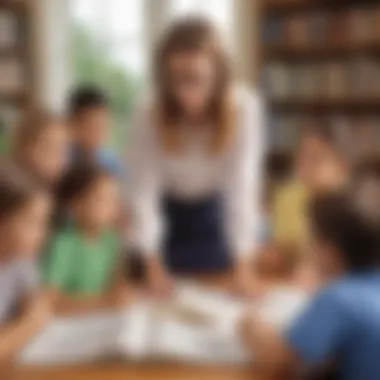Innovative Strategies Utilized by Educators to Elevate Elementary School Learning


Creative Activities
In the realm of education, employing creative activities to bolster learning among elementary school children is imperative. By infusing creativity into lessons, teachers can spark curiosity and engagement, fostering a deeper understanding of various subjects. Craft ideas serve as a fundamental avenue for children to express themselves artistically and enhance their fine motor skills. By sharing creative craft ideas that are both stimulating and achievable, educators can ignite the imaginations of young learners.
Step-by-step guides play a vital role in ensuring that children can easily replicate these craft projects. Detailed instructions break down complex tasks into manageable steps, empowering students to follow along and develop a sense of accomplishment upon completion. This method not only enhances their cognitive abilities but also nurtures their perseverance and attention to detail.
Furthermore, delving into the educational value of these creative activities reveals a multitude of benefits for young learners. Engaging in hands-on craft projects fosters creativity, critical thinking, and problem-solving skills. Moreover, it promotes concentration, patience, and the ability to follow instructions diligently, all of which are essential in academic and real-world settings.
Fun Quizzes
Integrating fun quizzes into the learning process can bring an element of enjoyment while reinforcing key concepts. When selecting quiz topics, teachers should consider subjects that align with the curriculum yet captivate children's interests. By covering a diverse range of topics on platforms like ElemFun, educators can cater to varying learning preferences and ensure comprehensive knowledge acquisition.
Diversifying question types within quizzes is crucial for engaging young minds. By incorporating multiple-choice, truefalse, and open-ended questions, teachers can assess different cognitive skills such as recall, analysis, and inference. This variety not only maintains children's interest but also stimulates critical thinking and analytical abilities.
Moreover, the role of quizzes extends beyond mere assessment; they serve as a potent tool for knowledge reinforcement. By offering immediate feedback on quiz responses, teachers can help students identify areas of strength and areas needing improvement. This instant reinforcement enhances information retention and motivates children to engage more deeply with the material.
Fact-Based Articles
Enriching the educational landscape with fact-based articles provides a platform for in-depth exploration and critical thinking. Covering a myriad of topics ensures that children are exposed to a wide spectrum of information, fostering a holistic understanding of the world around them. By addressing subjects that pique curiosity and relevance, educators can incite a thirst for knowledge and encourage independent research.
The presentation of engaging content within these articles is paramount to capturing children's attention and facilitating comprehension. Employing clear language, accessible examples, and visually appealing formats enhances readability and ensures that complex concepts are conveyed in a digestible manner. By structuring articles in a reader-friendly style, educators can instill a love for reading and learning in young learners.
Furthermore, providing additional resources such as links to related articles or external references expands children's learning beyond the confines of the classroom. By encouraging further exploration and research, educators empower students to delve deeper into subjects of interest, promoting autonomy and a lifelong passion for learning.
Understanding the Role of Teachers in Enhancing Learning
In the realm of education, teachers play a paramount role in shaping young minds and fostering a love for learning. Their impact goes beyond classroom instruction; they hold the key to unlocking the potential of elementary school children. Understanding the Role of Teachers in Enhancing Learning is crucial for ensuring that students receive the guidance and support needed to succeed academically and personally. By delineating clear learning objectives, employing innovative teaching methodologies, and creating conducive learning environments, teachers pave the way for educational excellence and holistic development.


Establishing Clear Learning Goals
One of the fundamental pillars in effective teaching is the establishment of clear learning goals. Setting precise and achievable objectives guides both teachers and students towards a common educational target. This strategic approach enables educators to chart a course for instruction, ensuring that each lesson contributes meaningfully to the overall educational journey of the students. Clear learning goals serve as roadmaps, allowing teachers to tailor their teaching methods to address specific learning outcomes. As such, they are instrumental in fostering a structured and purposeful learning environment that maximizes student engagement and comprehension.
Adopting Differentiated Instruction Techniques
Customizing Lesson Plans
Customizing lesson plans involves tailoring educational content and activities to meet the diverse needs and abilities of students. This personalized approach recognizes that learners have varying learning styles, preferences, and challenges. By customizing lesson plans, teachers can deliver instruction that resonates with each student, catering to their unique learning requirements. This differentiation strategy enhances student participation, comprehension, and overall academic performance. However, it requires careful planning and organization to ensure that individualized instruction is effectively implemented within the classroom setting.
Addressing Diverse Learning Styles
In addressing diverse learning styles, teachers acknowledge the multifaceted ways in which students absorb and process information. By incorporating auditory, visual, kinesthetic, and tactile elements into their teaching methodologies, educators create a rich and inclusive learning environment that accommodates a spectrum of learning preferences. This approach promotes equity and accessibility in education, enabling all students to thrive and succeed. While addressing diverse learning styles broadens the scope of instructional strategies, it also necessitates flexibility and creativity in curriculum design and delivery.
Utilizing Technology in the Classroom
Integration of Educational Apps
The integration of educational apps revolutionizes traditional teaching practices by leveraging digital resources to enhance the learning experience. Educational apps offer interactive and engaging content that supplements traditional lesson materials, making learning more dynamic and accessible. By incorporating these technologies, teachers can cater to varying learning paces and preferences, facilitating individualized instruction in a technologically immersive setting. However, effective integration of educational apps requires technological proficiency, strategic integration, and continual evaluation to optimize their educational impact.
Interactive Whiteboards Usage
Utilizing interactive whiteboards transforms classroom interactions by providing a visual and interactive platform for teaching and learning. Interactive whiteboards enable real-time collaboration, multimedia integration, and interactive engagement, fostering a dynamic and participatory learning environment. This technology promotes student involvement, comprehension, and critical thinking skills through interactive activities and visual stimuli. Yet, effective utilization of interactive whiteboards demands technical expertise, creativity in content delivery, and alignment with learning objectives to maximize their educational utility.
Creating a Stimulating Learning Environment
In this section, we delve deeply into the crucial role of Creating a Stimulating Learning Environment in enhancing the educational journey of elementary school children. By incorporating elements that stimulate curiosity and engagement, teachers can create a dynamic setting that fosters active learning. Such an environment not only encourages participation but also promotes critical thinking and holistic understanding. Educators must carefully consider factors such as classroom layout, use of visual aids, and interactive activities to craft a space that maximizes student engagement and knowledge retention.


Incorporating Visual Aids
The integration of visual aids, such as charts and diagrams, further enriches the learning experience. These graphical representations help in simplifying complex concepts, making them more accessible to young learners. Charts and diagrams visually organize information, aiding in information processing and comprehension. Their visual appeal captures students' attention and reinforces understanding through a different modality, catering to diverse learning styles within the classroom.
Charting the information through visual representations not only enhances retention but also makes abstract concepts more concrete, facilitating better knowledge transfer. Simultaneously, utilizing educational videos heightens student engagement and provides a multimedia learning experience. By incorporating visual and auditory cues, educational videos appeal to multiple senses, enhancing information retention and comprehension.
Encouraging Active Participation
Active participation through group activities cultivates collaboration and communication skills among students. Engaging in group tasks fosters teamwork, problem-solving, and peer learning, creating a dynamic learning environment rich in interaction and shared knowledge. Moreover, hands-on learning experiences invite tactile engagement, enabling students to apply theoretical concepts practically.
Promoting a Growth Mindset
Promoting a growth mindset nurtures resilience and perseverance in students, emphasizing the importance of effort and progress over fixed abilities. By praising effort and persistence, educators instill a belief in continuous improvement and a willingness to embrace challenges. Encouraging resilience cultivates a positive attitude towards learning, framing mistakes as opportunities for growth rather than failures.
Fostering Positive Teacher-Student Relationships
Fostering positive teacher-student relationships holds immense significance in this article as it serves as the foundation for effective learning environments. By prioritizing connections with students, teachers can enhance engagement, motivation, and overall academic performance. Building trust and rapport with students is essential to creating a supportive atmosphere where students feel valued and understood. Additionally, fostering positive teacher-student relationships contributes to improved communication, leading to clearer instruction and better feedback mechanisms to support student growth. The proactive cultivation of these relationships exemplifies the teacher's commitment to each student's holistic development and educational success.
Offering Constructive Feedback
Delivering constructive feedback is a critical component of the teaching process. By offering feedback that is specific, actionable, and focused on improvement, teachers can help students understand their strengths and areas needing development. Constructive feedback fosters student growth by providing guidance on how to enhance learning outcomes and acquire new skills. It plays a pivotal role in reinforcing positive behaviors and correcting misconceptions, ultimately empowering students to progress in their academic journey. Teachers who master the art of constructive feedback create a supportive learning environment where students feel encouraged to strive for excellence.
Creating a Supportive Learning Community
In the realm of education, creating a supportive learning community is essential for fostering collaboration, inclusivity, and overall student success. Building trust within the classroom environment establishes a foundation of respect, openness, and mutual understanding among students and between students and teachers. Trust enables individuals to take risks, share ideas, and engage in meaningful learning experiences without fear of judgment. Promoting inclusivity ensures that every student feels valued and respected, regardless of differences in background or abilities. Embracing diversity enriches the learning environment, providing students with varied perspectives and enhancing their critical thinking skills. By prioritizing inclusivity, teachers cultivate a culture of acceptance and support that empowers all students to thrive academically and socially.
Building Trust


Building trust is a key element in creating a supportive learning community. Establishing trust involves demonstrating reliability, honesty, and empathy towards students, fostering positive relationships and a sense of belonging within the classroom. Trust strengthens communication channels, encourages collaboration, and instills confidence in students, leading to a more engaging and productive learning environment. Students who trust their teachers are more likely to seek help, participate actively in class, and take academic risks, ultimately contributing to their academic growth and success.
Promoting Inclusivity
Promoting inclusivity plays a vital role in fostering a supportive learning community where every student feels respected and appreciated for their unique perspectives and contributions. Inclusivity involves acknowledging and celebrating differences among students, creating an environment where diversity is embraced and valued. By promoting inclusivity, teachers create a safe space for students to express themselves, share their experiences, and engage with diverse perspectives. Inclusive classrooms promote empathy, understanding, and tolerance, nurturing a sense of community and belonging among all students. Embracing inclusivity enriches the educational experience, broadening students' horizons and preparing them to thrive in a diverse and interconnected world.
Cultivating Effective Communication
Effective communication is the cornerstone of positive teacher-student relationships and successful learning outcomes. Active listening is a fundamental aspect of communication that involves fully concentrating on what students are saying, understanding their perspective, and responding thoughtfully. Active listening fosters empathy, trust, and mutual respect between students and teachers, enhancing comprehension and engagement in the learning process. Open dialogue encourages students to express their thoughts, ask questions, and engage in meaningful discussions that stimulate critical thinking and communication skills. By cultivating effective communication strategies, teachers create a vibrant learning environment where ideas are exchanged freely, learning is interactive, and students are empowered to take ownership of their education.
Implementing Assessments and Feedback Mechanisms
In the realm of education, the implementation of assessments and feedback mechanisms holds immense significance. It serves as a compass that guides teachers in evaluating student progress and understanding the effectiveness of their teaching strategies. By incorporating regular assessments and feedback mechanisms, educators gain valuable insights into the learning outcomes of elementary school children, allowing them to tailor instruction to meet individual needs. This process aids in identifying areas that require reinforcement, ultimately leading to an enhancement in overall academic performance.
Regular Formative Assessments
Regular formative assessments are essential components of the teaching-learning process. They offer teachers ongoing snapshots of student understanding and skill development, enabling timely interventions to address any gaps in learning. Through these assessments, educators can adjust instructional methods, provide additional support where necessary, and track progress over time. By integrating regular formative assessments, teachers create dynamic classroom environments that promote continual growth and improvement among students.
Encouraging Self-Reflection
Self-reflection is a powerful tool that fosters deeper learning and personal growth. When students engage in journaling activities, they are encouraged to introspect, articulate their thoughts, and reflect on their learning journey. Journaling activities not only enhance critical thinking and self-expression but also allow students to track their progress and set personal goals. By encouraging self-reflection, teachers empower students to take ownership of their learning, promoting a sense of autonomy and self-awareness.
Journaling activities
Journaling activities involve students recording their thoughts, feelings, and experiences in a structured format. This process encourages students to organize their ideas coherently, develop writing skills, and express themselves creatively. Journaling promotes metacognition, helping students make connections between new information and their existing knowledge. It also serves as a platform for students to explore their emotions, fears, and aspirations, fostering emotional intelligence and self-discovery.
Goal-setting exercises challenge students to define specific, achievable objectives and create actionable plans to reach them. By setting goals, students enhance their focus, motivation, and perseverance. Goal-setting exercises instill a sense of purpose and direction, encouraging students to strive for continuous improvement. These exercises cultivate a growth mindset, emphasizing the importance of effort, resilience, and perseverance in achieving personal and academic success.
Highlighting strengths
By highlighting students' strengths, teachers reinforce positive behavior, acknowledge achievements, and boost self-confidence. This practice encourages a positive self-concept, motivates further improvement, and cultivates a culture of appreciation and recognition. Highlighting strengths instills a sense of pride and accomplishment in students, fostering a positive attitude towards learning and personal development.
Identifying areas for improvement entails pinpointing weaknesses, challenges, or gaps in students' understanding. By identifying areas for improvement, teachers can provide targeted support, offer additional resources, and guide students towards enhancement. This approach promotes self-awareness, resilience, and a growth mindset, instilling a sense of determination and adaptability in students as they strive for academic excellence.







